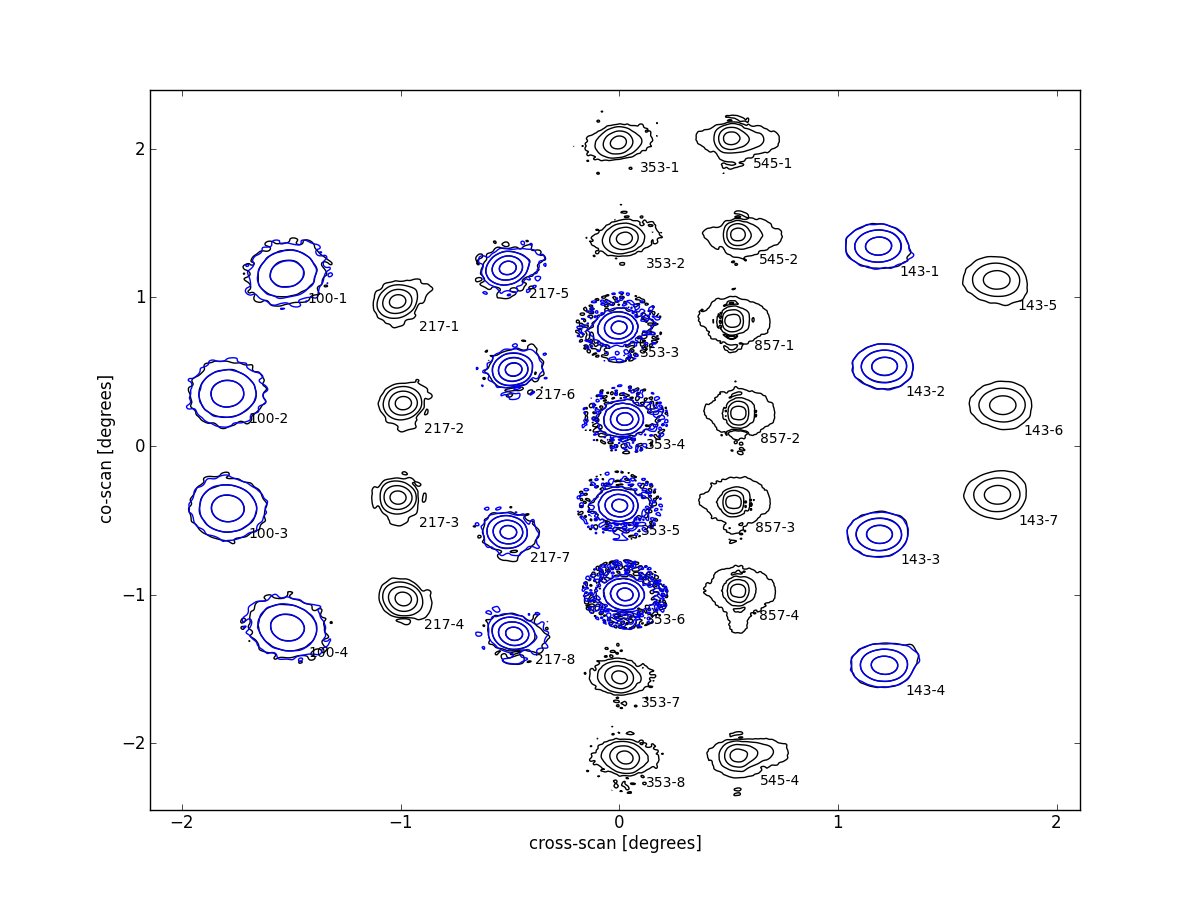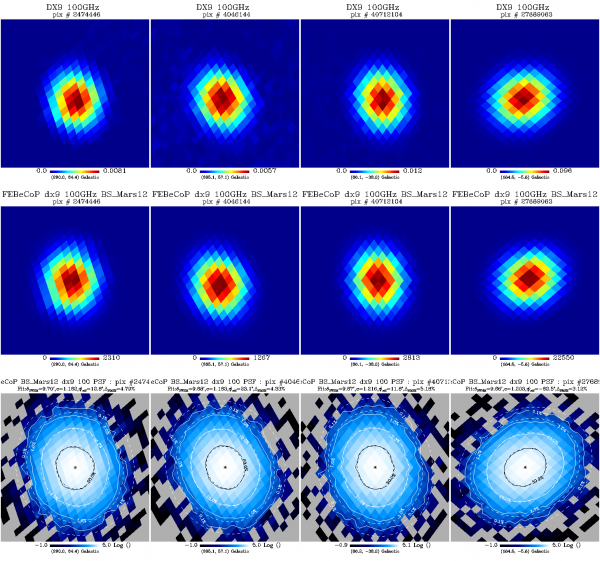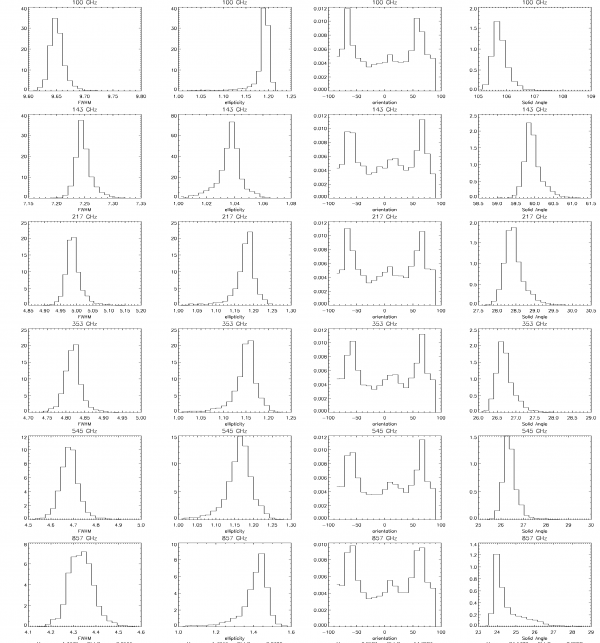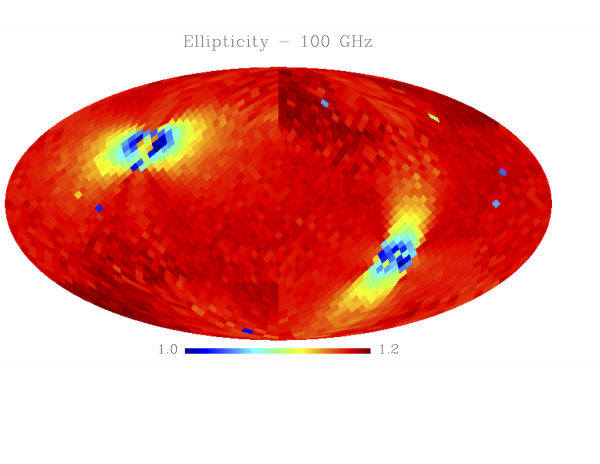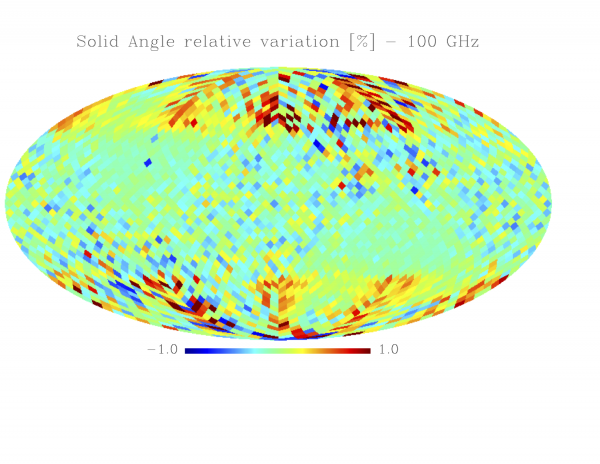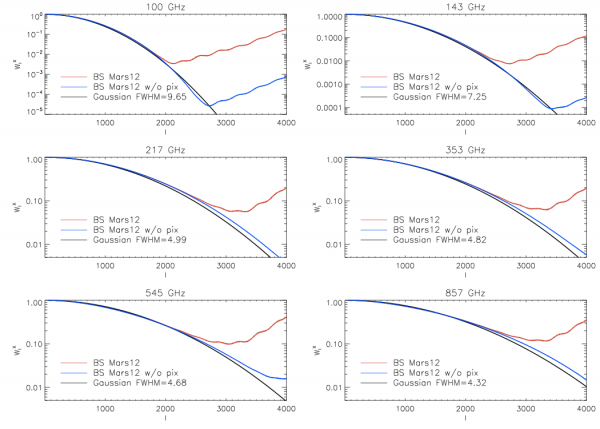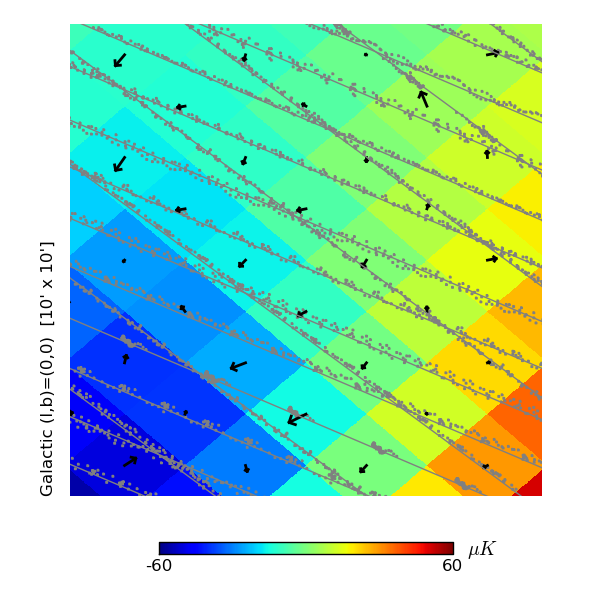Beams
Contents
- 1 Scanning Beams
- 2 Effective Beams
- 2.1 FEBeCoP
- 2.1.1 Pixel Ordered Detector Angles (PODA)
- 2.1.2 effBeam
- 2.1.3 Computational Cost
- 2.1.4 Inputs
- 2.1.5 The Focal Plane DataBase (FPDB)
- 2.1.6 The scanning strategy
- 2.1.7 The scanbeam
- 2.1.8 Beam cutoff radii
- 2.1.9 Map resolution for the derived beam data object
- 2.1.10 Comparison of the images of compact sources observed by Planck with FEBeCoP products
- 2.1.11 Histograms of the effective beam parameters
- 2.1.12 Sky variation of effective beams solid angle and ellipticity of the best-fit Gaussian
- 2.1.13 Statistics of the effective beams computed using FEBeCoP
- 2.1.14 Related products
- 2.1.15 Beam Window functions, Wl, for HFI channels
- 2.2 FICSBell
- 2.3 QuickBeam
- 2.4 Pixelization Artifacts
- 2.1 FEBeCoP
- 3 References
Scanning Beams[edit]
The scanning beams describe the instrument’s instantaneous beam profile. Due to the near constant spin rate of the spacecraft, time domain effects (including residual time response and lowpass filtering) are degenerate with the spatial response due to the optical system. The scanning beam reconstruction recovers both of these effects, aside from residual time domain effects on a longer time scale than can be captured with the extent of the scanning beam model.
In the paper cite P03c we consider two models of the beam in order to better understand systematics in the reconstruction. Here we describe only the BSpline beams which are used to compute the delivered effective beam (see next section).
BSpline Beam construction[edit]
We use seasons 1 and 2 of the Mars observation to reconstruct the beam. The data are processed with the bigPlanets TOI processing. We use JPL Horizons ephemerides to determine the pointing of each detector relative to the planet. We subtract the astrophysical background in the time domain using a bicubic interpolation of the Planck maps.
The time ordered data are used to fit a two dimensional BSpline surface using a least square minimization and a smoothing criterion to minimize the effects of high spatial frequency variations. We therefore assume the scanning beam to be smooth. The smoothing criterion as well as the locations of the nodes used to compute the B-Spline basis functions are set using GRASP physical optics simulations as inputs which are the best assumptions on the spatial frequency content of the in-flight beams.
The smoothing criterion is defined as follows:
And the global inversion criterion :
with usual least square estimator and coefficient giving the relative weight to with respect to the smoothing criterion.
The BSpline nodes are located on a regular spaced grid in the detector coordinate framset. At the edge of the reconstructed beam map area, 4 coincident nodes are added to avoid vanishing basis functions.
Let , degree B-Spline build using nodes {} (De Boor & Cox, 1972) :
Simulations and errors[edit]
We estimate the reconstruction bias and noise in the measurements using an ensemble of simulated planet observations for each channel. Kept fixed in each simulation are:
- the input beam assumed: we use a supersampled version of the reconstructed BSpline beam (or whatever comes out of the current ongoing tests!)
- Astrophyical background is the same as that subtracted from the real data.
- StarTracker pointing (using the ptcor6 pointing model).
The following are varied in each simulation:
- detector noise realizations obtained by filtering randomly generated white noise with the measured noise PSDs
- random pointing errors with 2 arcsecond rms, and a spectrum that replicates the real errors.
- simulated glitches and the deglitching procedure
- Mars brightness temperature variability
400 simulated timelines are generated for each bolometer and for each of the two seasons of Mars observations used in the beam reconstruction. The simulated timelines are made into beam maps, projecting onto the BSpline basis in the same way as the real data.
The beam maps are propagated to effective beam window functions using the quickbeam approach (see effective beams below) and used to evaluate the reconstruction bias and to construct error eigenmodes in the effective beam window function.
Figure: random pointing error PSD Figures: error envelope plots (or should those go under effective beams?)
Residuals[edit]
There are two known beam effects that are not included in the main beam model and are estimated as a separate bias in flux and angular power spectrum measurement: 1. long tails due to errors in low frequency time response deconvolution, and 2. near sidelobes.
We stack all five observations of Jupiter to estimate the long time scale residuals due to incomplete deconvolution of the long time scale response.
Add some kind of mean tail plot
Near sidelobes are also evaluated using stacked Jupiter (hopefully they will just be part of the v53bis BSpline beams). The main features in the near sidelobes include a wide beam skirt, and dimpling lobes Add sidelobe plots and tables
Effective Beams[edit]
Several methods of effective beams determination have been developped and cross-validated. Need satisfactory comparison plot
FEBeCoP[edit]
The effective beam is the average of all scanning beams pointing at a certain direction within a given pixel of the sky map for a given scan strategy. It takes into account the coupling between azimuthal asymmetry of the beam and the uneven distribution of scanning angles across the sky. It captures the complete information about the difference between the true and observed image of the sky. They are, by definition, the objects whose convolution with the true CMB sky produce the observed sky map.
The full algebra involving the effective beams for temperature and polarisation was presented in [Mitra, Rocha, Gorski et al.] #mitra2010. Here we summarise the main results. The observed temperature sky is a convolution of the true sky and the effective beam :
where
is time samples, is if the pointing direction falls in pixel number , else it is , represents the exact pointing direction (not approximated by the pixel centre location), and is the centre of the pixel number , where the scanbeam is being evaluated (if the pointing direction falls within the cut-off radius of FWHM.
The algebra is a bit more involved for polarised detectors. The observed stokes parameters at a pixel , , are related to the true stokes parameters , by the following relation:
where the polarised effective beam matrix
and and are the the polarisation weight vectors, as defined in \cite{mitra2010}.
The task is to compute for temperature only beams and the matrices for each pixel , at every neighbouring pixel that fall within the cut-off radius around the the center of the pixel.
The effective beam is computed by stacking within a small field around each pixel of the HEALPix sky map. Due to the particular features of Planck scanning strategy coupled to the beam asymmetries in the focal plane, and data processing of the bolometer and radiometer TOIs, the resulting Planck effective beams vary over the sky.
FEBeCoP, given information on Planck scanning beams and detector pointing during a mission period of interest, provides the pixelized stamps of both the Effective Beam, EB, and the Point Spread Function, PSF, at all positions of the HEALPix-formatted map pixel centres.
The methodology for computing effective beams for a scanning CMB experiment like Planck
was presented in [Mitra, Rocha, Gorski et al.].
FEBeCoP, or Fast Effective Beam Convolution in Pixel space, is an approach to representing and computing effective beams (including both intrinsic beam shapes and the effects of scanning) that comprises the following steps:
- identify the individual detectors' instantaneous optical response function (presently we use elliptical Gaussian fits of Planck beams from observations of planets; eventually, an arbitrary mathematical representation of the beam can be used on input)
- follow exactly the Planck scanning, and project the intrinsic beam on the sky at each actual sampling position
- project instantaneous beams onto the pixelized map over a small region (typically <2.5 FWHM diameter)
- add up all beams that cross the same pixel and its vicinity over the observing period of interest
- create a data object of all beams pointed at all N'_pix_' directions of pixels in the map at a resolution at which this precomputation was executed (dimension N'_pix_' x a few hundred)
- use the resulting beam object for very fast convolution of all sky signals with the effective optical response of the observing mission
Computation of the effective beams at each pixel for every detector is a challenging task for high resolution experiments. FEBeCoP is an efficient algorithm and implementation which enabled us to compute the pixel based effective beams using moderate computational resources. The algorithm used different mathematical and computational techniques to bring down the computation cost to a practical level, whereby several estimations of the effective beams were possible for all Planck detectors for different scanbeam models and different lengths of datasets.
Pixel Ordered Detector Angles (PODA)[edit]
The main challenge in computing the effective beams is to go through the trillion samples, which gets severely limited by I/O. In the first stage, for a given dataset, ordered lists of pointing angles for each pixels---the Pixel Ordered Detector Angles (PODA) are made. This is an one-time process for each dataset. We used computers with large memory and used tedious memory management bookkeeping to make this step efficient.
effBeam[edit]
The effBeam part makes use of the precomputed PODA and unsynchronized reading from the disk to compute the beam. Here we tried to made sure that no repetition occurs in evaluating a trigonometric quantity.
One important reason for separating the two steps is that they use different schemes of parallel computing. The PODA part requires parallelisation over time-order-data samples, while the effBeam part requires distribution of pixels among different computers.
Computational Cost[edit]
The whole computation of the effective beams has been performed at the NERSC Supercomputing Center. In the table below it isn displayed the computation cost on NERSC for nominal mission both in terms of CPU hrs and in Human time.
| Channel | 100 | 143 | 217 | 353 | 545 | 857 |
| PODA/Detector Computation time (CPU hrs) | 500 | 500 | 500 | 500 | 500 | 500 |
| PODA/Detector Computation time (Human minutes) | 20 | 20 | 20 | 20 | 20 | 20 |
| Beam/Channel Computation time (CPU hrs) | 2800 | 3800 | 3200 | 3000 | 900 | 1100 |
| Beam/Channel Computation time (Human hrs) | 1.5 | 2 | 1.2 | 1 | 0.5 | 0.5 |
| Convolution Computation time (CPU hr) | 3.6 | 4.8 | 4.0 | 4.1 | 4.1 | 3.7 |
| Convolution Computation time (Human sec) | 4 | 4 | 4 | 4 | 4 | 4 |
| Effective Beam Size (GB) | 187 | 182 | 146 | 132 | 139 | 124 |
The computation cost, especially for PODA and Convolution, is heavily limited by the I/O capacity of the disc and so it depends on the overall usage of the cluster done by other users.
Inputs[edit]
In order to fix the convention of presentation of the scanning and effective beams, we show the classic view of the Planck focal plane as seen by the incoming CMB photon (top plot in this page). The scan direction is marked, and the toward the center of the focal plane is at the 85 deg angle w.r.t spin axis pointing upward in the picture.
The Focal Plane DataBase (FPDB)[edit]
The FPDB contains information on each detector, e.g., the orientation of the polarisation axis, different weight factors, ... (see the instrument RIMOs):
- HFI - LFI_RIMO_DX9_PTCOR6 - The HFI RIMO
The scanning strategy[edit]
The scanning strategy, the three pointing angle for each detector for each sample: Detector pointings for the nominal mission covers about 15 months of observation from Operational Day (OD) 91 to OD 563 covering 3 surveys and half.
The scanbeam[edit]
The scanbeam modeled for each detector through the observation of planets. Which was assumed to be constant over the whole mission, though FEBeCoP could be used for a few sets of scanbeams too.
- HFI: B-Spline, BS based on 2 observations of Mars.
(see the instrument RIMOs)
- HFI - LFI_RIMO_DX9_PTCOR6 - The HFI RIMO
Beam cutoff radii[edit]
N times geometric mean of FWHM of all detectors in a channel, where N
| channel | Cutoff Radii in units of fwhm | fwhm of full beam extent |
| 100 | 2.25 | 23.703699 |
| 143 | 3 | 21.057402 |
| 217-353 | 4 | 18.782754 |
| sub-mm | 4 | 18.327635(545GHz) ; 17.093706(857GHz) |
Map resolution for the derived beam data object[edit]
- for HFI frequency channels
Comparison of the images of compact sources observed by Planck with FEBeCoP products[edit]
We show here a comparison of the FEBeCoP derived effective beams, and associated point spread functions,PSF (the transpose of the beam matrix), to the actual images of a few compact sources observed by Planck, for 100GHz frequency channels, as an example. We show below a few panels of source images organized as follows:
- Row #1- DX9 images of four ERCSC objects with their galactic (l,b) coordinates shown under the color bar
- Row #2- linear scale FEBeCoP PSFs computed using input scanning beams, Grasp Beams, GB, for LFI and B-Spline beams,BS, Mars12 apodized for the CMB channels and the BS Mars12 for the sub-mm channels, for HFI (see section Inputs below).
- Row #3- log scale of #2; PSF iso-contours shown in solid line, elliptical Gaussian fit iso-contours shown in broken line
Histograms of the effective beam parameters[edit]
Here we present histograms of the three fit parameters - beam FWHM, ellipticity, and orientation with respect to the local meridian and of the beam solid angle. The shy is sampled (pretty sparsely) at 3072 directions which were chosen as HEALpix nside=16 pixel centers for HFI to uniformly sample the sky.
Where beam solid angle is estimated according to the definition: 4pi* sum(effbeam)/max(effbeam) ie
Sky variation of effective beams solid angle and ellipticity of the best-fit Gaussian[edit]
- The discontinuities at the Healpix domain edges in the maps are a visual artifact due to the interplay of the discretized effective beam and the Healpix pixel grid.
Statistics of the effective beams computed using FEBeCoP[edit]
We tabulate the simple statistics of FWHM, ellipticity (e), orientation () and beam solid angle, (), for a sample of 3072 directions which were chosen as HEALpix nside=16 pixel centers for HFI data. Statistics shown in the Table are derived from the histograms shown above.
- The derived beam parameters are representative of the DPC NSIDE 2048 healpix maps (they include the pixel window function).
- The reported FWHM_eff are derived from the beam solid angles, under a Gaussian approximation. These are best used for flux determination while the the Gaussian fits to the effective beam maps are more suited for source identification.
| frequency | mean(fwhm) [arcmin] | sd(fwhm) [arcmin] | mean(e) | sd(e) | mean() [degree] | sd() [degree] | mean() [arcmin] | sd() [arcmin] | FWHM_eff [arcmin] |
|---|---|---|---|---|---|---|---|---|---|
| 100 | 9.651 | 0.014 | 1.186 | 0.023 | -0.024 | 55.400 | 105.778 | 0.311 | 9.66 |
| 143 | 7.248 | 0.015 | 1.036 | 0.009 | 0.383 | 54.130 | 59.954 | 0.246 | 7.27 |
| 217 | 4.990 | 0.025 | 1.177 | 0.030 | 0.836 | 54.999 | 28.447 | 0.271 | 5.01 |
| 353 | 4.818 | 0.024 | 1.147 | 0.028 | 0.655 | 54.745 | 26.714 | 0.250 | 4.86 |
| 545 | 4.682 | 0.044 | 1.161 | 0.036 | 0.544 | 54.876 | 26.535 | 0.339 | 4.84 |
| 857 | 4.325 | 0.055 | 1.393 | 0.076 | 0.876 | 54.779 | 24.244 | 0.193 | 4.63 |
Beam solid angles for the PCCS[edit]
- - is the mean beam solid angle of the effective beam, where beam solid angle is estimated according to the definition: 4pi*sum(effbeam)/max(effbeam), i.e. as an integral over the full extent of the effective beam, i.e. .
- from we estimate the , under a Gaussian approximation - these are tabulated above
- is the beam solid angle estimated up to a radius equal to one and up to a radius equal to twice the .
- These were estimated according to the procedure followed in the aperture photometry code for the PCCS: if the pixel centre does not lie within the given radius it is not included (so inclusive=0 in query disc).
| Band | [arcmin] | spatial variation [arcmin] | [arcmin] | spatial variation-1 [arcmin] | [arcmin] | spatial variation-2 [arcmin] |
| 100 | 105.778 | 0.311 | 100.830 | 0.410 | 105.777 | 0.311 |
| 143 | 59.954 | 0.246 | 56.811 | 0.419 | 59.952 | 0.246 |
| 217 | 28.447 | 0.271 | 26.442 | 0.537 | 28.426 | 0.271 |
| 353 | 26.714 | 0.250 | 24.827 | 0.435 | 26.653 | 0.250 |
| 545 | 26.535 | 0.339 | 24.287 | 0.455 | 26.302 | 0.337 |
| 857 | 24.244 | 0.193 | 22.646 | 0.263 | 23.985 | 0.191 |
Related products[edit]
Monte Carlo simulations[edit]
FEBeCoP software enables fast, full-sky convolutions of the sky signals with the Effective beams in pixel domain. Hence, a large number of Monte Carlo simulations of the sky signal maps map convolved with realistically rendered, spatially varying, asymmetric Planck beams can be easily generated. We performed the following steps:
- generate the effective beams with FEBeCoP for all frequencies for dDX9 data and Nominal Mission
- generate 100 realizations of maps from a fiducial CMB power spectrum
- convolve each one of these maps with the effective beams using FEBeCoP
- estimate the average of the Power Spectrum of each convolved realization, C'_\ell_'^out^'}, and 1 sigma errors
As FEBeCoP enables fast convolutions of the input signal sky with the effective beam, thousands of simulations are generated. These Monte Carlo simulations of the signal (might it be CMB or a foreground (e.g. dust)) sky along with LevelS+Madam noise simulations were used widely for the analysis of Planck data. A suite of simulations were rendered during the mission tagged as Full Focalplane simulations, FFP#.
For example FFP6
Beam Window Functions[edit]
The Transfer Function or the Beam Window Function relates the true angular power spectra with the observed angular power spectra :
Note that, the window function can contain a pixel window function (depending on the definition) and it is {\em not the angular power spectra of the scanbeams}, though, in principle, one may be able to connect them though fairly complicated algebra.
The window functions are estimated by performing Monte-Carlo simulations. We generate several random realisations of the CMB sky starting from a given fiducial , convolve the maps with the pre-computed effective beams, compute the convolved power spectra , divide by the power spectra of the unconvolved map and average over their ratio. Thus, the estimated window function
For subtle reasons, we perform a more rigorous estimation of the window function by comparing C^{conv}_l with convolved power spectra of the input maps convolved with a symmetric Gaussian beam of comparable (but need not be exact) size and then scaling the estimated window function accordingly.
Beam window functions are provided in the RIMO.
Beam Window functions, Wl, for HFI channels[edit]
To be coordinated with GracaSee Mitra et al (2011
FICSBell[edit]
For more details, see #planck2013-p03c
Since the HFI beams are not azimuthally symmetric, the scanning strategy has to be taken into account in the effective beam response modelling. This is done using the FICSBell method (Hivon et al, in preparation), which generalizes to polarization and to include other sources of systematics the approach used for TT estimation in WMAP-3yr Hinshaw et al (2007) and by Smith et al (2007) in the detection of CMB lensing in WMAP maps. The different steps of the method used for this study can be summarized as follows:
The scanning related information (i.e., statistics of the orientation of each detector within each pixel) is computed first, and only once for a given observation campaign. Those orientation hit moments are only computed up to degree 4, for reasons described in point 2 below. At the same time, the first two moments of the distribution of samples within each pixel (ie, their center of mass and moments of inertia) are computed and stored on disc.
The scanning beam map or beam model of each detector is analyzed into its Spherical Harmonics coefficients
where is the beam map centered on the North pole, and is the Spherical Harmonics basis function. Higher indexes describes higher degrees of departure from azimuthal symmetry and, for HFI beams, the coefficients are decreasing functions of at most considered. It also appears that, for , the coefficients with account for or less of the beam throughput. For this reason, only modes with are considered in the present analysis. Armitage-Caplan and Wandelt (2009) reached a similar conclusion in their deconvolution of Planck-LFI beams.
The coefficients computed above are used to generate -spin weighted maps, as well as the first and second order derivatives, for a given CMB sky realization.
The spin weighted maps and orientation hit moments of the same order are combined for all detectors involved, to provide an “observed” map. Similarly the local spatial derivatives are combined with the location hit moments to describe the effect of the non-ideal sampling of each pixel (see [sec:pixelization]). In this combination, the respective number of hits of each detector in each pixel is considered, as well as the weighting (generally proportional to the inverse noise variance) applied to each detector in order to minimize the final noise.
The power spectrum of this map can then be computed, and compared to the input CMB power spectrum to estimate the effective beam window function over the whole sky, or over a given region of the sky.
Monte-Carlo (MC) simulations in which the sky realisations are changed can be performed by repeating steps 3, 4 and 5. The impact of beam model uncertainties can be studied by including step 2 into the MC simulations.
QuickBeam[edit]
For more details, see #planck2013-p03c
Planck observes the sky after convolution with a “scanning beam”, which captures its effective response to the sky as a function of displacement from the nominal pointing direction. Decomposing the scanning beam into harmonic coefficients , each time-ordered data (TOD) sample can be modelled as (neglecting the contribution from instrumental noise, which is independent of beam asymmetry) where the TOD samples are indexed by , and is the underlying sky signal. The spin spherical harmonic rotates the scanning beam to the pointing location , while the factor gives it the correct orientation. Eq. may be evaluated with the “TotalConvolver” algorithm of Wandelt and Gorski (2001), accelerated using the “conviqt” recursion relations Prezeau and Reinecke (2010) This approach is implemented in LevelS. </ref>, although because it involves working with a TOD-sized objected it is necessarily slow.
On the small angular scales comparable to the size of the beam, it is a good approximation to assume that the procedure of mapmaking from TOD samples is essentially a process of binning: where is the total number of hits in pixel .
Start with a normalized, rescaled harmonic transform of the beam , sky multipoles and a scan history object given by where the sum is over all hits of pixel at location , and is the scan angle for observation . The harmonic transform of this scan-strategy object is given by The beam-convolved observation is then given by Taking the ensemble average of the pseudo-Cl power spectrum of these we find
where is a cross-power spectrum of scan history objects. Note that the w(n,s) which we have used here can also incorporate a position dependent weighting to optimize the pseudo-Cl estimate, such as inverse-noise or a mask– the equations are unchanged. Writing the pseudo-Cl in position space (a la Dvorkin and Smith (2009)) with Wigner-d matrices we have
This integral can be implemented exactly using Gauss-Legendre quadrature, with a cost of $\cal 0(l_{\rm max}^2 s_{\rm max}^2)$. For simplicity, we’ve written all the equations here for the auto-spectrum of a single detector, but the generalization to a map made by adding several detectors with different weighting is straightforward. The cost to compute all of the necessary terms exactly in that case becomes .
Are beams really so difficult? On the flat-sky beam convolution is easy: just multiplication in Fourier space by a beam rotated onto the scan direction. Multiple hits with different scan directions are incorporated by averaging (as the “scan history” objects above encapsulate). Does the sphere really require everything to be so complicated? For a scan strategy which is fairly smooth across the sky, we can pretend that we are observing many independent flat-sky patches at high-L with fairly good accuracy. There is in fact a fairly good approximation to the beam convolved pseudo-Cl power spectrum which is essentially a flat-sky approximation. In the limit that , with and being slowly-varying function in the pseudo-Cl sum above can be approximated as where the average is taken over the full sky. It’s illustrative to consider three limits of this equation: for a “raster” scan strategy in which each pixel is observed with the same direction, we have and the predicted pseudo-Cl is just the power spectrum of the beam. For a "best-case" scan strategy, in which each pixel is observed many times with many different orientation angles, we have < | w(, M) |2 >p = M0, and the transfer function is just the azimuthally symmetric part of the beam. Note that this is for a full-sky observation– in the presence of a mask, the average above produces an fsky factor, as expected. It just neglects the coupling between L multipoles (which can be calculated with the more complete equations above).
Effective beam window functions[edit]
The effective beam window functions $B(l)$ for HFI, computed using Quickbeam, are available in the RIMO. They do not contain the pixel window function.
Pixelization Artifacts[edit]
For more details, see #planck2013-p03c
- Several codes available to simulate effects of pixelization.
- Mixes the CMB gradient into a pixelization ``noise with a level comparable to that of $2\mu Karcmin$ instrumental noise.
- Quantitative estimate of effect should be included with each released map, but expect not to matter significantly for CMB analysis, as small compared to instrumental noise.
[sec:pixelization]
Planck maps are produced at resolution 11 , corresponding to pixels with a typical dimension of , comparable to the spacing between scanning rings . This results in an uneven distribution of hits within pixels, which introduces some complications in the analysis and interpretation of the maps. A sample of the hit distribution is illustrated in Fig. [fig:pixcoverage]. Below we discuss the simulation and modeling of this pixelization effect in more detail.
[fig:pixcoverage]
The collaboration has produced 3 codes which may be used to simulate the effect of pixelization on the observed sky, LevelS/TotalConvoler/Conviqt, FeBeCoP, and FICSBell references and further discussion of the three methods and how they each simulate the pixelization effect..
For the measurement of CMB fluctuations, it is also possible to gain intuition for the effects of pixelization analytically. On the small scales relevant to pixelization, the observed CMB is smooth, both due to physical damping as well as the convolution of the instrumental beam. Taylor expanding the CMB temperature about a pixel center to second order, the typical gradient amplitude is given by where the approximate value is calculated for a cosmology with a fwhm Gaussian beam. The typical curvature of the observed temperature, on the other hand is given by On the scales relevant to the maximum displacement from the center of a pixel, the maximum displacement is , and so the gradient term tends to dominate, although the curvature term is still non-negligible. For each observation of a pixel, we can denote the displacement from the pixel center as . The average over all hits within a pixel gives an overall deflection vector which we will denote for a pixel center located at as . This represents the center of mass of the hit distribution; in Fig. [fig:pixcoverage] we have plotted these average deflections using black arrows. The deflection field may be decomposed into spin-1 spherical harmonics as With a second order Taylor expansion of the CMB temperature about each pixel center, it is then possible to calculate the average pseudo-Cl power spectrum of the pixelized sky. This is given by
where is half the mean-squared deflection magnitude (averaged over hits within a pixel, as well as over pixels). is the sum of the gradient and curl power spectra of , and is the gradient spectrum minus the curl spectrum. The term describes a smearing of the observed sky due to pixelization. For uniform pixel coverage of pixels . For the hit distribution of Planck frequency maps, is typically within xxx. calculate for final maps, looks like will be better than 10%percent of this value, and so this term is accurately described by the pixel window function, which is derived under the assumption of uniform pixel coverage.
The effect of pixelization is essentially degenerate with that of gravitational lensing of the CMB, with the difference that it (1) acts on the beam-convolved sky, rather than the actual sky and (2) produces a curl-mode deflection field as well as a gradient mode. This is discussed further in the [#planck2013-p12|Planck gravitational lensing] paper, where the subpixel deflection field constitutes a potential source of bias for the measured lensing potential. Indeed, Eq. [eqn:cltpixelized] is just a slightly modified version of the usual first order CMB lensing power spectrum (Hu (2000), Lewis and Challinor (2006)) to accommodate curl modes.
A useful approximation to Eq. which is derived in the unrealistic limit that the deflection vectors are uncorrelated between pixels, but in practice gives a good description of the power induced by the pixelization, is that the couples the CMB gradient into a source of noise with an effective level given by
where the average is taken over all pixels and is half the mean-squared power in the CMB gradient: For frequency-combined maps, is typically on the order of , and so the induced noise is at the level of . This is small compared to the instrumental contribution, although it does not disappear when taking cross-spectra, depending on how coherent the hit distributions of the two maps in the cross-spectrum are.
References[edit]
<biblio force=false>
</biblio>
Cosmic Microwave background
Full-Width-at-Half-Maximum
(Hierarchical Equal Area isoLatitude Pixelation of a sphere, <ref name="Template:Gorski2005">HEALPix: A Framework for High-Resolution Discretization and Fast Analysis of Data Distributed on the Sphere, K. M. Górski, E. Hivon, A. J. Banday, B. D. Wandelt, F. K. Hansen, M. Reinecke, M. Bartelmann, ApJ, 622, 759-771, (2005).
(Planck) High Frequency Instrument
(Planck) Low Frequency Instrument
reduced IMO
Operation Day definition is geometric visibility driven as it runs from the start of a DTCP (satellite Acquisition Of Signal) to the start of the next DTCP. Given the different ground stations and spacecraft will takes which station for how long, the OD duration varies but it is basically once a day.
Early Release Compact Source Catalog
Data Processing Center
